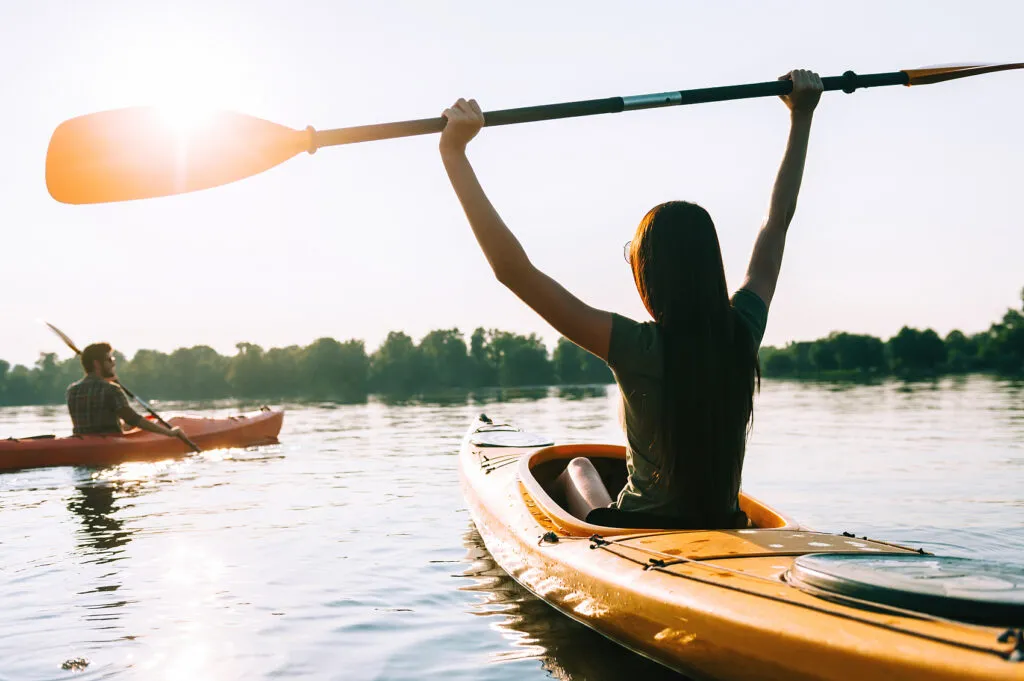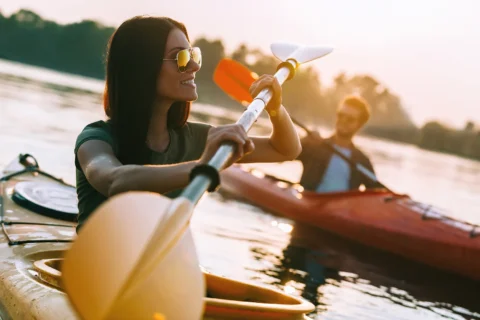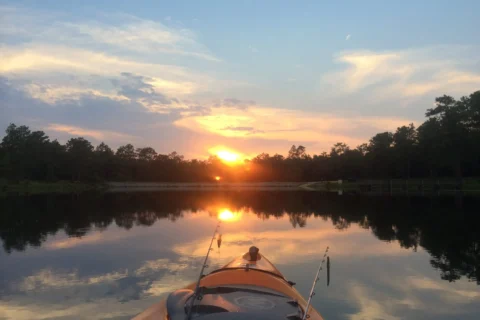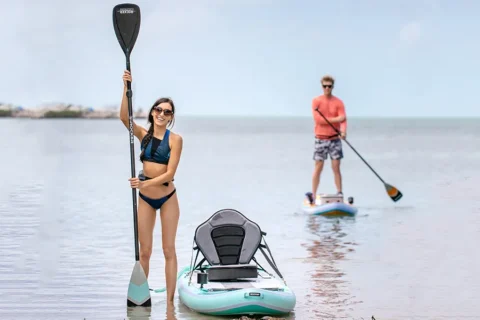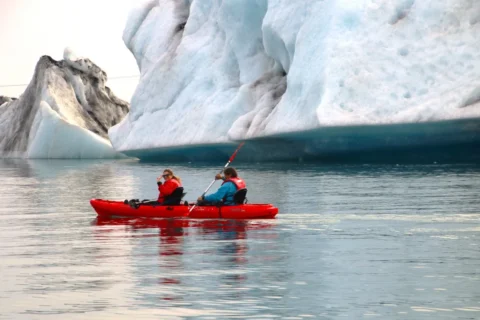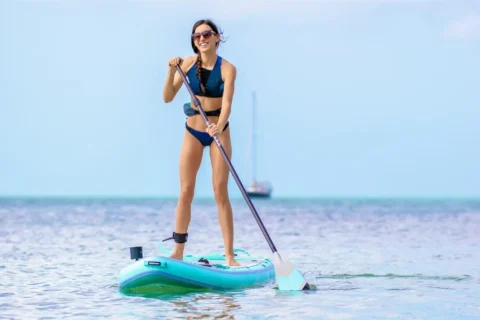Kayaking has long been a popular activity for outdoor enthusiasts, offering both adventure and a way to connect with nature. As we look to the future, kayaking is poised to evolve in exciting ways. Advances in technology, a growing focus on environmental sustainability, and changes in how people engage with recreational activities all play a role in shaping the future of this beloved water sport. This blog will delve into these trends and what they mean for the future of kayaking.
Technological Advancements in Kayak Design
One of the most significant areas of innovation in kayaking is the design and construction of the kayaks themselves. Advances in materials science and manufacturing techniques are leading to lighter, stronger, and more versatile kayaks.
- Materials:
- Composite Materials: Traditional kayaks are often made from polyethylene, but future kayaks will increasingly use advanced composite materials. Carbon fiber and Kevlar are becoming more common, offering high strength-to-weight ratios. These materials not only make kayaks lighter but also more durable and efficient on the water.
- Eco-Friendly Materials: Sustainability is a growing concern, and manufacturers are exploring biodegradable and recycled materials. Innovations in bioplastics and plant-based resins could lead to eco-friendly kayaks that don’t sacrifice performance.
- Manufacturing Techniques:
- 3D Printing: The rise of 3D printing technology offers exciting possibilities for custom kayak design. Enthusiasts and professionals can print kayaks tailored to specific needs and preferences. This technology also allows for rapid prototyping and the development of complex structures that would be difficult or impossible with traditional manufacturing methods.
- Automation and Precision: Automation in manufacturing can improve precision and reduce costs. Robots and advanced machinery can ensure that each kayak is built to exact specifications, improving quality and performance.
- Hydrodynamics:
- Improved Designs: Computational fluid dynamics (CFD) and other advanced modeling tools enable designers to optimize kayak shapes for better speed and stability. Future kayaks will likely feature more refined hull designs that reduce drag and enhance performance.
- Adjustable Features: Some future kayaks may include adjustable hull features that can be modified on the fly to suit different water conditions. This adaptability can provide a more versatile paddling experience.
Enhanced Safety and Comfort Features
As kayaking grows in popularity, there is an increasing emphasis on safety and comfort. New technologies and design innovations are making kayaking safer and more accessible for everyone.
- Safety Innovations:
- Built-in GPS and Communication Systems: Future kayaks may come equipped with integrated GPS and communication systems. These features can help paddlers navigate more effectively and call for help in emergencies. Some advanced models may even include automated distress signals.
- Stability Enhancements: New hull designs and stabilizing technologies can make kayaks more stable and less prone to capsizing. Outriggers and self-righting mechanisms are potential innovations that could improve safety, especially in rough waters.
- Comfort Enhancements:
- Ergonomic Seating: Innovations in ergonomic design are leading to more comfortable seating options. Adjustable seats that provide better support can reduce fatigue and enhance the overall kayaking experience.
- Climate Control Features: In regions with extreme temperatures, kayaks with built-in climate control features such as ventilation systems or heating elements can make outings more comfortable.
- Accessibility:
- Adaptive Equipment: As kayaking becomes more inclusive, there is a growing market for adaptive equipment. Kayaks with modifications for paddlers with disabilities are becoming more common, allowing more people to enjoy the sport.
Environmental Sustainability
The future of kayaking is closely tied to environmental sustainability. As outdoor enthusiasts, kayakers have a vested interest in preserving natural waterways. The industry is taking steps to minimize its environmental impact and promote conservation.
- Eco-Friendly Manufacturing:
- Sustainable Materials: As mentioned earlier, the use of biodegradable and recycled materials is on the rise. Companies are investing in research to develop materials that reduce environmental impact.
- Low-Impact Manufacturing Processes: Advances in manufacturing techniques can also reduce waste and energy consumption. Companies are adopting more sustainable practices, such as using renewable energy sources and minimizing emissions.
- Conservation Efforts:
- Partnerships with Environmental Organizations: Kayak manufacturers and retailers are partnering with environmental organizations to support conservation efforts. These partnerships can help protect vital waterways and promote sustainable practices among kayakers.
- Eco-Friendly Products: Products such as solar-powered kayak accessories and environmentally safe cleaning supplies are becoming more common. These innovations help reduce the environmental footprint of kayaking activities.
- Education and Advocacy:
- Promoting Leave No Trace Principles: Kayaking organizations are emphasizing the importance of Leave No Trace principles. Education campaigns and training programs can help paddlers minimize their impact on the environment.
- Advocacy for Clean Waterways: Kayakers are often at the forefront of efforts to protect and restore waterways. Advocacy for clean water initiatives and participation in clean-up events can make a significant difference.
Integration of Technology
Technology is playing an increasingly important role in kayaking. From smart devices to advanced tracking systems, the integration of technology is transforming the way people experience the sport.
- Smart Kayaks:
- Integrated Electronics: Future kayaks may feature integrated electronics, such as built-in fish finders, GPS systems, and weather monitors. These tools can enhance safety and provide valuable information for paddlers.
- Connected Devices: The use of connected devices and apps can improve trip planning and tracking. Paddlers can share routes, monitor conditions, and stay connected with other kayakers through mobile apps and social media platforms.
- Augmented Reality (AR) and Virtual Reality (VR):
- Training and Simulation: AR and VR technologies can provide realistic training experiences. Paddlers can practice their skills in virtual environments before heading out on the water.
- Enhanced Navigation: AR can offer real-time navigation aids, displaying information on a heads-up display. This can help paddlers navigate unfamiliar waters more confidently.
- Environmental Monitoring:
- Water Quality Sensors: Kayaks equipped with water quality sensors can collect valuable environmental data. This information can be used for research and conservation efforts.
- Wildlife Monitoring: Kayakers can contribute to wildlife monitoring programs by using technology to record sightings and track movements.
The Rise of Kayak Fishing
Kayak fishing is a rapidly growing segment of the kayaking community. Advances in kayak design and fishing gear are making this activity more accessible and enjoyable.
- Fishing-Specific Kayaks:
- Stable Platforms: Fishing kayaks are designed for stability, allowing anglers to stand and cast comfortably. Wider hulls and improved stability features make fishing from a kayak easier.
- Storage Solutions: Kayak manufacturers are incorporating more storage options for fishing gear. Features such as rod holders, tackle storage, and live wells are becoming standard.
- Advanced Fishing Gear:
- Electronic Aids: Fish finders, GPS systems, and other electronic aids are enhancing the kayak fishing experience. These tools help anglers locate fish and navigate efficiently.
- Customizable Accessories: Modular accessories allow anglers to customize their kayaks for specific needs. This includes mounts for cameras, lights, and additional rod holders.
- Community and Competitions:
- Kayak Fishing Tournaments: Competitive kayak fishing is gaining popularity. Tournaments and events bring together anglers to compete and share their experiences.
- Online Communities: Online forums and social media groups provide a platform for kayak anglers to connect, share tips, and showcase their catches.
Expanding Access to Kayaking
Making kayaking more accessible to a broader audience is essential for the growth of the sport. Efforts are being made to ensure that people of all ages, backgrounds, and abilities can enjoy kayaking.
- Affordability:
- Budget-Friendly Options: Manufacturers are producing more budget-friendly kayaks without compromising quality. This makes the sport more accessible to newcomers.
- Rental and Sharing Programs: Kayak rental services and sharing programs allow people to experience kayaking without the need to purchase equipment. This can be especially appealing for those who only paddle occasionally.
- Education and Training:
- Instructional Programs: Kayaking schools and instructional programs are expanding. These programs teach essential skills and safety techniques, making it easier for beginners to get started.
- Youth Programs: Introducing kayaking to young people through school programs and youth organizations can foster a lifelong interest in the sport.
- Inclusive Initiatives:
- Adaptive Kayaking: Efforts to provide adaptive kayaking equipment and programs are growing. This ensures that individuals with disabilities can enjoy the sport.
- Diverse Outreach: Outreach programs aimed at underrepresented communities are helping to diversify the kayaking population. These initiatives promote inclusivity and provide opportunities for everyone to experience kayaking.
The Role of Kayaking in Health and Wellness
Kayaking offers numerous physical and mental health benefits. As more people recognize these benefits, kayaking is becoming an important part of health and wellness routines.
- Physical Fitness:
- Cardiovascular Health: Paddling provides a great cardiovascular workout. It helps improve heart health and endurance.
- Strength and Flexibility: Kayaking works various muscle groups, enhancing strength and flexibility. It is a low-impact exercise, making it suitable for people of all ages.
- Mental Health:
- Stress Reduction: Being on the water can have a calming effect. Kayaking provides a break from the stresses of daily life and can improve mental well-being.
- Mindfulness and Relaxation: The rhythmic nature of paddling and the peaceful surroundings encourage mindfulness and relaxation. It can be a meditative experience.
- Social Connection:
- Group Activities: Kayaking with friends or joining a paddling club fosters social connections. Group activities can enhance the enjoyment of the sport.
- Community Building: Participating in local kayaking events and clean-up initiatives builds a sense of community. It encourages people to work together towards common goals.
Future Trends in Kayaking Destinations
The popularity of kayaking is influencing the development of new destinations and experiences. The future will see a broader range of kayaking opportunities.
- Adventure Tourism:
- Exotic Locations: Adventure tourism is growing, and kayaking is a key component. Exotic locations like tropical islands, remote rivers, and polar regions offer unique kayaking experiences.
- Eco-Tourism: Eco-tourism destinations that focus on sustainability and conservation are becoming more popular. Kayaking through protected areas and wildlife reserves provides an immersive nature experience.
- Urban Kayaking:
- City Waterways: Urban kayaking is on the rise. Cities are developing their waterways to accommodate recreational activities. Paddling through city canals, harbors, and rivers offers a different perspective of urban environments.
- Waterfront Developments: Waterfront developments are incorporating kayak-friendly infrastructure. Launch sites, rental facilities, and guided tours make it easier to enjoy urban kayaking.
- Virtual and Augmented Experiences:
- Virtual Reality Tours: Virtual reality tours can provide a taste of kayaking in various locations around the world. This can inspire people to try real-life kayaking adventures.
- Augmented Reality Enhancements: Augmented reality can enhance real-world kayaking experiences by providing information about the surroundings, wildlife, and historical sites.
Environmental Impact and Conservation
The future of kayaking is closely linked to environmental health. As more people take to the water, it’s important to ensure that kayaking activities are sustainable and contribute to conservation efforts.
- Sustainable Practices:
- Minimizing Impact: Kayakers are adopting practices that minimize environmental impact. This includes avoiding sensitive areas, reducing waste, and following Leave No Trace principles.
- Eco-Friendly Products: The development of eco-friendly kayaking products, such as biodegradable sunscreen and environmentally safe cleaning supplies, helps reduce the ecological footprint of paddling activities.
- Conservation Efforts:
- Waterway Clean-Ups: Kayakers are often involved in waterway clean-up efforts. Organized events and volunteer initiatives help keep rivers, lakes, and coastal areas clean.
- Wildlife Protection: Kayaking can provide opportunities for wildlife observation and data collection. Paddlers can contribute to citizen science projects and help monitor and protect local wildlife.
- Advocacy and Education:
- Promoting Conservation: Kayaking organizations are advocating for the protection of waterways and natural habitats. Education campaigns raise awareness about environmental issues and promote conservation efforts.
- Sustainable Tourism: Promoting sustainable tourism practices ensures that kayaking destinations are preserved for future generations. Responsible tourism supports local economies and protects natural resources.
Conclusion
The future of kayaking is bright, with numerous innovations and trends shaping the sport. Advances in technology, a focus on environmental sustainability, and a commitment to inclusivity are all driving the evolution of kayaking. As we look ahead, kayaking will continue to offer exciting opportunities for adventure, fitness, and connection with nature. By embracing these changes and promoting responsible practices, we can ensure that kayaking remains a beloved and accessible activity for generations to come. Whether you’re a seasoned paddler or a newcomer to the sport, the future of kayaking promises endless possibilities for exploration and enjoyment.
